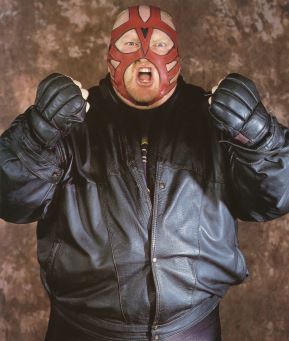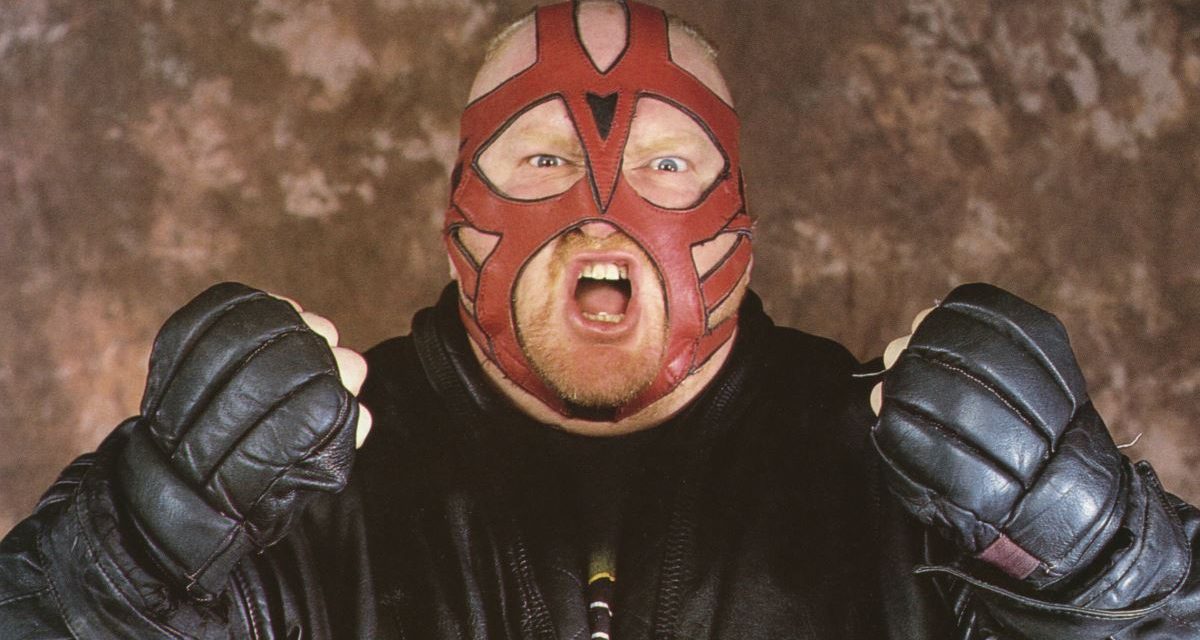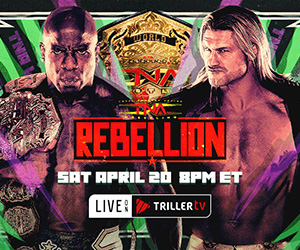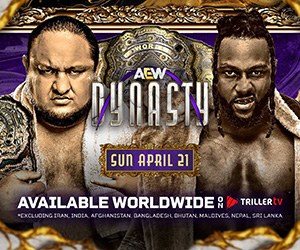
Vader in a WWF promo shot from 1998. Photo by Tom Buchanan.
Leon White, the football star turned professional wrestler known as Vader and Big Van Vader, has died. He was 63 years old, and had been battling numerous health issues in recent years.
WWE.com reported that White died on Monday night, June 18; White’s son said he died around 7:25 p.m. local time in Colorado. He had been battling pneumonia for a month.
Vader will be remembered as one of the very best big men ever in professional wrestling. Carrying anywhere from 330 to 415 pounds on his 6-foot-4 frame, he could astound audiences with his power or his agility, defying gravity with thunderous moonsaults. He was violent and dominating, believable in the UWFI shootfighting promotion or as a monster heel in the WWF.
Those with crafty minds for the business saw gold in those massive loins. “Vader was a big, huge guy. Here’s a big, huge guy that could move. He had great credentials. He was impressive. He had his gimmick down. He understood his gimmick. He was a good guy to have,” said Bill Watts.
In a 1993 interview with the Pro Wrestling Torch, Paul Heyman raved about Vader. “When a man that size does a moonsault with a blown out back, when a man that size does the things he does and is willing to do for other people, that impresses me a lot more than when a 230 pound guy does it.”
Growing up in Lynwood, Calif., White was working by the seventh grade to help make ends meet at home, walking three miles to a bowling alley in inner-city Los Angeles. “Jesus, I was working an 11-7 shift at the Gage Bowling Alley in inner-city L.A., and then walking home three miles, at that age, just because we were broke,” White said in 2006. “I would do that on a couple of school nights. I’ve worked hard my whole life, and it’s not about hard work or being involved in something.”
He was a highly sought-after recruit in football from L.A.’s Bell High School, and chose the wide open spaces and blue skies of University of Colorado. The center was a two-time All-American, captain of the team when he graduated with a degree in Business Administration. He was chosen in the third round of the 1978 NFL draft, 80th overall, by the Los Angeles Rams, the team he grew up worshipping. He signed a five-year deal, but was only active for three of those seasons, rupturing his patella tendon during a sweep against the Dallas Cowboys.
His football career done, he returned to Boulder, Colo., and got a real estate license, built townhouses and owned and operated a car wash. He wasn’t fulfilled, however. “I got bored stiff,” White told the Wrestle Radio U.S.A. program. “I was gaining a lot of weight and becoming way out of shape and becoming a real businessman. But I decided to sell everything. The home, the car wash, condominiums, everything.”
White left for Minneapolis, where former Olympian Brad Rheingans trained prospective pro wrestlers outside of town. As “Baby Bull” Leon White, he barely made a ripple in the AWA in 1986, but did get an invitation to Europe to work for the CWA. Promoter Otto Wanz saw something in White, and through the regular work, the American made it to the top as CWA World champ. Up next, Antonio Inoki came courting, and actually bought out White’s contract with Wanz.
Though Sid Vicious and Ultimate Warrior had apparently been considered, the role of Big Van Vader was given to White. Derived from Japanese folklore, where Vader was a top warrior who once fought for his village 72 hours straight, White was given a huge, black device for his head that shot smoke. In an unheard of move, Vader, managed by a late night TV host, beat Inoki in the main event at Tokyo’s Sumo Hall in less than three minutes. A new star was born.
“He revolutionized what people thought of a monster heavyweight wrestler. He elevated the standards of what it meant to be an agile giant who could make fans believe that he could destroy everyone,” said puroresu expert Zach Arnold. Vader would again rise to be world champion in Japan (as well as in Mexico). “Years ago, Vader had an angle with Kenta Kobashi in All Japan in which Vader stiffed Kobashi over the eye and Kobashi was bleeding hardway, only for Vader to continue pounding on the eye more. This kind of realism is what Vader could add to his style in Japan that he likely couldn’t in later years in the WWF.”
Fans in North America will remember Vader from his world title run in WCW, where he feuded with Sting, Ric Flair and Ron Simmons. Sting said Vader was real stiff when he returned from Japan. “I’m the guy that tamed him,” said Sting. “He just came out and beat the crap out of me. It was like that for a long time, but by the time he got tamed, and we started to get things down and work out a match, we had some phenomenal, I think, really good matches. I always like working against the monster. He was a monster, and to big as he was and to do a moonsault was pretty amazing.”
“He was an incredibly strong man, without a doubt. Carrying that kind of mass, I always wavered between them, does he know his own strength or does he know it and just not care?” said Nikita Koloff, who Vader ended the career of, both in the ring and in storylines. Vader’s WWF stint, which began in 1996, never brought him the success enjoyed anywhere else.
In August 1995, Leon White was involved in a dust-up with Paul Orndorff in Atlanta while both were employed by WCW. The massive White’s years of aggressiveness on the football field and in the ring as Big Van Vader were no match for the veteran Orndorff, who diffused the tense situation with relative ease. White’s reputation behind the scenes took a hefty blow, just another in a series of missteps that plagued his incredibly successful career.
“He just made so many dumb mistakes. He goes and tries to beat Paul Orndorff up. He goes and beats up a young boy in All Japan, and the mafia, they hold him down and slice him up. So many dumb things have happened to the guy,” said fellow popular gaijin in Japan Scott Norton. “The longer he’s away from the business, the more they’ll respect him. Leon, he’s a massive guy, just what we call a real hard night, hard match to work.”
Or, as his former manager Harley Race puts it, “Leon White was Leon’s biggest enemy. He never really liked anything anybody did. Personality-wise, he was a big asshole.”
In the end, Vader’s public legacy is his dominance in Japan (where he competed into his 50s), but to those in the know, his self-absorption lost him respect. “When I would wrestle Vader, it was a fight. It was just a brawl. It was just pecking rights,” said Norton. “He was so worried about what was going on. And Leon, he was one of the best big men to ever wrestle.”
It’s not a sentiment that White denied.
“Quite frankly, I made a little noise. Some people say I’m the best superheavyweight to ever wrestle. So what. That and a dime won’t make me a cup of coffee, won’t buy me a cup of coffee,” White said in 2006. “At 450 pounds, I was about 440, and one night I weighed in and I wrestled Sting for 35-plus minutes. Some said he was breathing harder than me. No other superheavyweight at 450 pounds could have done that, and did moonsaults, and off the top rope dropkicks, and did what I did.”
At the personal level, White’s life spiraled down in 2007, coming home from a tour of Japan to an empty home in Colorado, his wife having left him. He recognized his battles with alcohol especially were an issue and tried to get the better of it.
He had a double knee replacement, but infection set in, confining him to bed for six months. A tour of Japan was aborted when he went unconscious on the plane, and he spent 30 days in a coma, waking 112 pounds lighter with trouble walking. A group called the Wounded Warriors Alliance invited him to be a part of their meetings, helping him get his life back on track.
White’s son, Jesse, was a football star at the University of Oklahoma, but a hip injury kept him from probably playing in the NFL. He later followed his father into pro wrestling, even teaming with his Dad on occasion. He had a WWE developmental deal in 2011.
In November 2016, he was involved in a car accident where his car rolled over, and not long after, he announced that he had been diagnosed with congestive heart failure due to his football and wrestling careers. He had open-heart surgery surgery in March 2018, then faced down pneumonia and bronchitis, before having another surgery in May to fix an irregular heartbeat.
White had just completed his autobiography with author Kenny Casanova.
MORE VADER STORIES
- Mar. 7, 2022: Vader to be inducted into WWE Hall of Fame
- Feb. 6, 2021: Brace yourself for the tale of the man they called Vader
- Mar. 16, 2014: Vader gives insight into the WCW of 1993
- Jan. 24, 2010: Ringside with Vader a solid shoot
- Jan. 6, 2000: Vader rejuvenated in Japan



